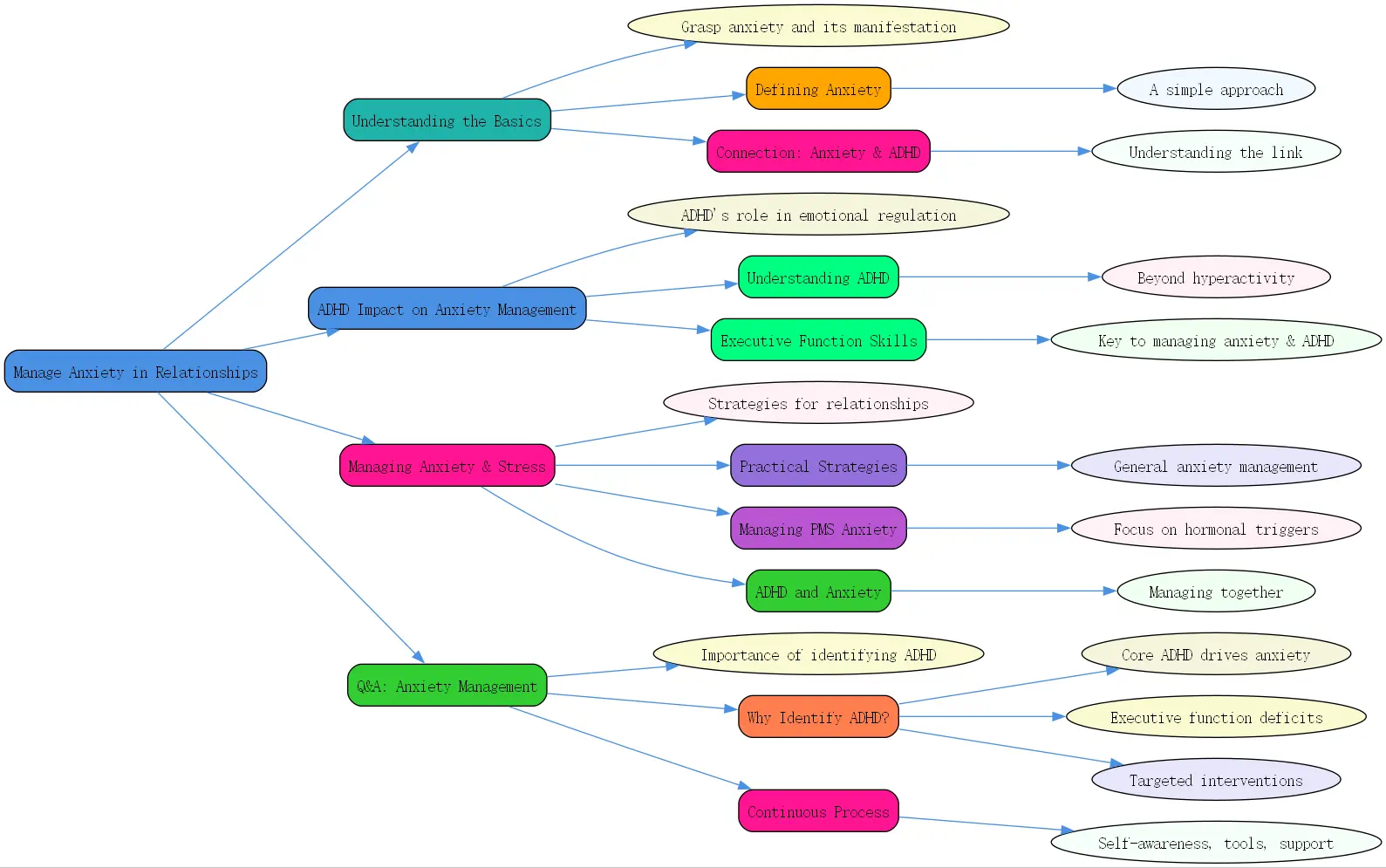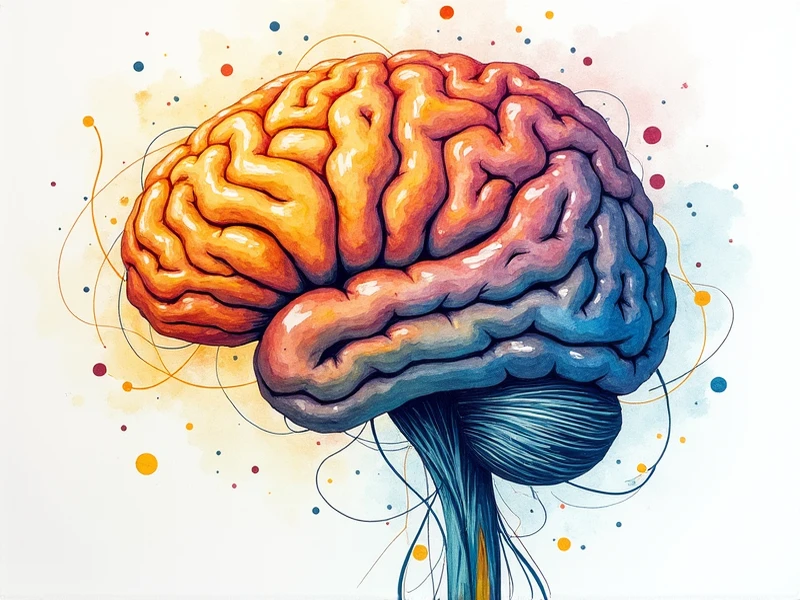Navigating relationships can be complex, and when anxiety enters the picture, it adds another layer of difficulty. Many people struggle with feelings of worry, fear, or unease within their partnerships, sometimes without fully understanding the source. Understanding the nature of anxiety, its potential links to conditions like ADHD, and learning practical coping strategies are crucial steps towards fostering healthier, more secure connections. At BrainTalking, we believe knowledge empowers change.
This article delves into how to manage anxiety in relationships, exploring its definition, its connection to neurodevelopmental conditions like ADHD, and providing actionable tips to manage anxiety and stress. We’ll also touch upon specific challenges like how to manage PMS anxiety and how to manage ADHD and anxiety concurrently.
How to Manage Anxiety in Relationships: Understanding the Basics

Before tackling management strategies, it’s essential to grasp what anxiety truly is and how it can manifest, sometimes in conjunction with other conditions like ADHD. Recognizing the underlying mechanisms is the first step towards effective intervention.
Defining Anxiety: A Simple Approach
Anxiety often feels like a vague sense of dread or nervousness, but understanding its core can be clarifying. Dr. Jennifer Erickson, a specialist in anxiety and ADHD, offers a straightforward definition: anxiety is essentially a physiological response to excessive worry. It’s the body’s physical reaction ??think adrenaline or cortisol surges ??triggered by persistent overthinking, fear, and apprehension.
While dictionary definitions mention nervousness, physical signs like sweating or a racing pulse, and mental states like doubt or fear, the key takeaway is the link between thought patterns and bodily reactions. These physical sensations ??a pounding heart, shallow breathing, trembling ??can be distressing, making individuals fearful of the anxiety itself. This cycle often originates from cognitive patterns, sometimes starting in childhood, where we develop persistent worries about judgment, failure, or not being good enough.
Over time, these ingrained thought patterns can trigger the body’s stress response, leading to the physical experience of anxiety. It’s not just “”in your head””; it’s a full-body experience initiated by the mind’s interpretation of perceived threats or challenges, whether real or imagined. Recognizing this mind-body connection is fundamental to managing anxiety effectively.
The Connection Between Anxiety and ADHD
Interestingly, the journey to understanding anxiety sometimes uncovers other underlying conditions, notably Attention-Deficit/Hyperactivity Disorder (ADHD). Dr. Erickson notes that her work specializing in anxiety frequently led her to identify undiagnosed ADHD in clients who felt particularly “”stuck”” despite therapy efforts. These individuals could make progress in some areas but remained inexplicably blocked in others.

This overlap occurs because the challenges associated with ADHD, especially difficulties with executive function skills, can significantly contribute to anxiety. Executive functions are the brain’s management system, responsible for planning, focusing, remembering instructions, and juggling tasks. When these skills are impaired, as they often are in ADHD, daily life can feel overwhelming, leading to chronic stress and anxiety.
Imagine constantly struggling to organize thoughts, meet deadlines, or manage impulses. This internal struggle can easily breed feelings of inadequacy, frustration, and worry about performance or letting others down, which are hallmarks of anxiety. Therefore, identifying underlying ADHD can be crucial for effectively treating persistent anxiety, as it allows for targeted strategies addressing both conditions.
ADHD and Its Impact on Anxiety Management
Understanding ADHD itself is vital, particularly its less-obvious presentations and its direct impact on the skills needed for emotional regulation and stress management. It’s more than just hyperactivity; it involves core neurological differences in how the brain processes information and manages tasks.
Understanding ADHD: Beyond Hyperactivity
ADHD is formally recognized as a neurodevelopmental disorder, meaning it originates in the brain’s development, typically with an onset in early childhood. While many associate ADHD with the stereotypical image of a hyperactive child bouncing off the walls, this only represents one facet of the condition. The Diagnostic and Statistical Manual of Mental Disorders (DSM) outlines three main presentations.
These include the Predominantly Hyperactive/Impulsive type, the Predominantly Inattentive type (formerly known simply as ADD), and the Combined type. The inattentive presentation is frequently missed, especially during childhood. These individuals might not be disruptive; instead, they may seem dreamy, struggle to follow instructions, lose things frequently, or have difficulty sustaining focus on tasks that aren’t highly stimulating.
Because they might perform well academically or socially some of the time, their struggles are often misinterpreted as laziness, lack of motivation, or carelessness. Dr. Erickson highlights that these individuals might excel one week and be completely unable to function the next, leading to confusing inconsistencies. This pattern of intermittent success can mask the underlying neurological challenge, preventing diagnosis and appropriate support, often leading to internalized criticism and anxiety later in life.
Executive Function Skills: The Key to Managing Anxiety and ADHD
Executive functions are central to understanding the link between ADHD and anxiety. As defined by the Harvard University Center on the Developing Child, these mental processes enable us to plan, focus attention, remember instructions, and manage multiple tasks successfully. Think of them as the brain’s air traffic control system, managing the flow of information, prioritizing tasks, filtering distractions, and controlling impulses.
These skills include working memory (holding information in mind to use it), cognitive flexibility (shifting perspectives or approaches), and inhibitory control (resisting impulses and distractions). They are crucial for setting and achieving goals, analyzing situations, thinking critically, and adapting to changing circumstances. When executive functions are weak, individuals struggle significantly with organization, time management, emotional regulation, and task initiation.
This deficit directly impacts how to manage anxiety and stress. Poor planning can lead to feeling overwhelmed, difficulty filtering distractions heightens sensitivity to stressors, and weak impulse control can result in regrettable reactions that fuel further anxiety, especially in relationships. Recognizing the role of executive function provides a clear target for interventions aimed at managing both ADHD symptoms and related anxiety. Strengthening these skills is often key.
Tips to Manage Anxiety and Stress in Relationships
Managing anxiety, whether general or linked to specific triggers like PMS or ADHD, requires a multi-faceted approach. Here are practical strategies and considerations for navigating anxiety within the context of relationships and daily life.
Practical Strategies for Managing Anxiety
Several evidence-based approaches offer effective tips to manage anxiety and stress:
- Cognitive Behavioral Therapy (CBT): This therapy focuses on identifying and challenging negative thought patterns that fuel anxiety. By learning to reframe worries and change behavioral responses to anxious triggers, individuals can gain significant control over their anxiety. Techniques might include thought records or behavioral experiments. [Consider linking to a BrainTalking article on CBT techniques here].
- Mindfulness and Meditation: These practices train the brain to focus on the present moment without judgment. Regular mindfulness or meditation can reduce the physiological arousal associated with anxiety, calming the racing heart and shallow breathing. Apps like Headspace or Calm offer guided sessions.
- Physical Exercise: Regular physical activity is a powerful anxiety reliever. Exercise releases endorphins, improves sleep, and reduces muscle tension. Finding an enjoyable activity, whether it’s walking, dancing, or yoga, can make a significant difference in overall stress levels.
- Healthy Lifestyle Choices: Adequate sleep, a balanced diet low in processed foods and caffeine, and limiting alcohol intake can all support better emotional regulation and reduce vulnerability to anxiety triggers.
How to Manage PMS Anxiety
For many individuals who menstruate, the premenstrual phase brings a noticeable spike in anxiety and irritability, often referred to as PMS anxiety. This is largely due to hormonal fluctuations, particularly changes in estrogen and progesterone, which can impact neurotransmitters related to mood, like serotonin. Learning how to manage PMS anxiety involves recognizing this pattern and implementing targeted strategies.
Understanding your cycle through tracking can help anticipate these periods and practice extra self-care. Dietary adjustments, such as reducing sugar, caffeine, and alcohol while increasing complex carbohydrates and calcium-rich foods, may help stabilize mood. Some find relief with supplements like Magnesium, Vitamin B6, or Calcium, but it’s crucial to consult a healthcare professional before starting any new supplement regimen. Stress reduction techniques like gentle yoga, deep breathing exercises, or journaling become particularly important during this time.
Acknowledging the biological basis of PMS anxiety can also reduce self-blame. Communicating these patterns to a partner can foster understanding and support within the relationship during more challenging days of the month. It transforms the experience from a personal failing into a manageable, predictable cycle.
How to Manage ADHD and Anxiety Together
When ADHD and anxiety coexist, management requires an integrated approach that addresses both conditions. Simply treating the anxiety without acknowledging the underlying ADHD often leads to limited success, as the executive function challenges continue to generate stress. Learning how to manage ADHD and anxiety involves several key components.
Therapeutic approaches should ideally address both. This might involve CBT adapted for ADHD, focusing on practical strategies for organization, time management, and emotional regulation alongside traditional anxiety techniques. Therapy might also explore how ADHD traits like Rejection Sensitivity Dysphoria (RSD) ??an intense emotional pain triggered by perceived rejection or criticism ??contribute to relationship anxiety. Psychoeducation about ADHD is crucial for self-understanding and reducing self-criticism.
Medication management, overseen by a qualified healthcare professional (like a psychiatrist), may be considered. Stimulant or non-stimulant medications for ADHD can improve focus and reduce impulsivity, indirectly lessening anxiety by making daily tasks more manageable. Sometimes, separate medications for anxiety are also needed. Building executive function skills through targeted exercises, coaching, or tools (planners, apps, reminders) is fundamental. Improving these skills reduces the daily friction that often fuels anxiety for those with ADHD, making it easier to navigate work, life, and relationships. Understanding how to manage anxiety in relationships when ADHD is present means addressing the core executive function deficits alongside the anxious thoughts and feelings.
Key Takeaways for Managing Anxiety:
- Understand Anxiety: Recognize it as a physiological response to excessive worry, linking mind and body.
- Consider ADHD: Be aware that persistent anxiety, especially feeling “”stuck,”” might indicate underlying ADHD and executive function challenges.
- Target Executive Function: Strengthening skills like planning, focus, and impulse control is key for managing both ADHD and anxiety.
- Use Practical Strategies: Employ CBT, mindfulness, exercise, and healthy lifestyle choices as foundational anxiety management tools.
- Address Specific Triggers: Implement targeted approaches for PMS anxiety (hormonal awareness, diet, stress reduction).
- Integrate ADHD & Anxiety Care: Combine therapy, potential medication, and executive function skill-building for co-occurring conditions.
- Communicate in Relationships: Openly discussing anxiety triggers and needs (including those related to PMS or ADHD) fosters understanding and support.

Q&A: Understanding Anxiety Management
Q: Why is identifying underlying ADHD so important when trying to manage anxiety?
A: Identifying underlying ADHD is crucial because the core characteristics of ADHD, particularly executive function deficits, can be significant drivers of anxiety. If only the anxiety symptoms are treated without addressing the root causes related to ADHD, progress can be limited or unsustainable. For example, someone might learn CBT techniques to challenge anxious thoughts about work performance, but if they continue to struggle with time management, organization, and task initiation due to undiagnosed ADHD, they will likely keep facing situations that trigger anxiety (e.g., missing deadlines, feeling overwhelmed).
Furthermore, the constant effort required to compensate for ADHD challenges can be mentally and physically exhausting, contributing to chronic stress and burnout, which exacerbate anxiety. Misinterpreting ADHD struggles as personal failings (“”I’m lazy,”” “”I’m not trying hard enough””) also fuels negative self-talk and low self-esteem, core components of anxiety disorders. Recognizing ADHD allows for targeted interventions like psychoeducation (reducing self-blame), ADHD medication (improving focus and reducing impulsivity), and executive function coaching (building practical skills). This integrated approach addresses the source of many anxiety triggers, leading to more effective and lasting relief, particularly improving how to manage anxiety in relationships where executive function plays a role in communication, planning, and reliability.




